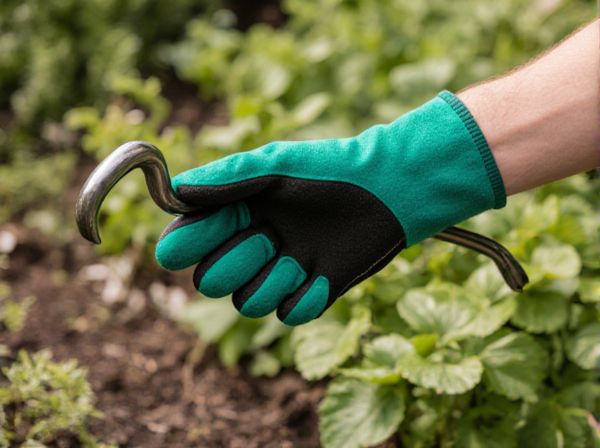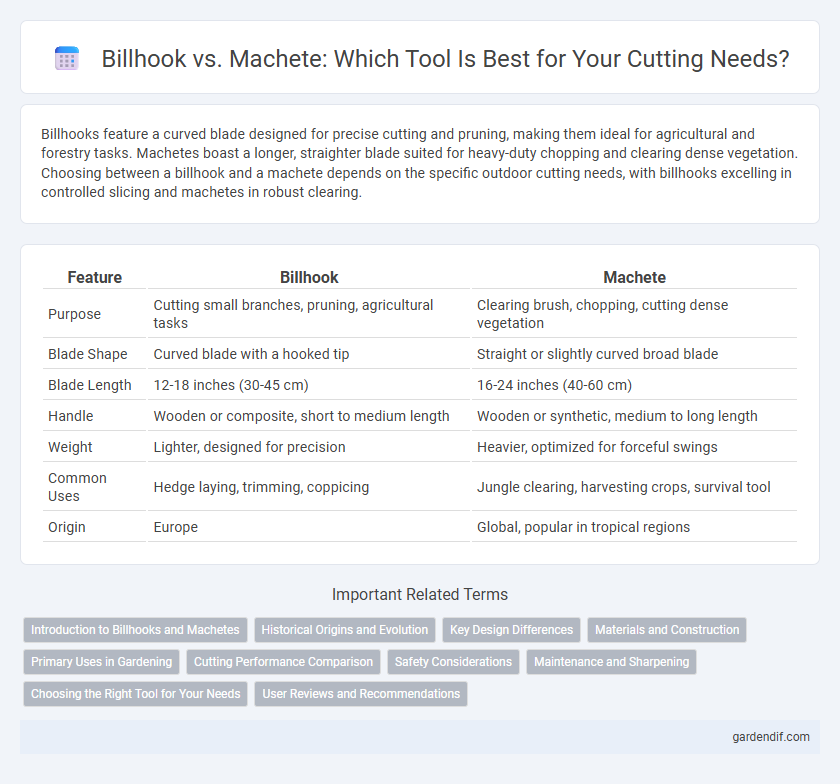
Billhook vs Machete Illustration
Billhooks feature a curved blade designed for precise cutting and pruning, making them ideal for agricultural and forestry tasks. Machetes boast a longer, straighter blade suited for heavy-duty chopping and clearing dense vegetation. Choosing between a billhook and a machete depends on the specific outdoor cutting needs, with billhooks excelling in controlled slicing and machetes in robust clearing.
Table of Comparison
| Feature | Billhook | Machete |
|---|---|---|
| Purpose | Cutting small branches, pruning, agricultural tasks | Clearing brush, chopping, cutting dense vegetation |
| Blade Shape | Curved blade with a hooked tip | Straight or slightly curved broad blade |
| Blade Length | 12-18 inches (30-45 cm) | 16-24 inches (40-60 cm) |
| Handle | Wooden or composite, short to medium length | Wooden or synthetic, medium to long length |
| Weight | Lighter, designed for precision | Heavier, optimized for forceful swings |
| Common Uses | Hedge laying, trimming, coppicing | Jungle clearing, harvesting crops, survival tool |
| Origin | Europe | Global, popular in tropical regions |
Introduction to Billhooks and Machetes
Billhooks and machetes are cutting tools designed for different purposes in agriculture and forestry. Billhooks feature a curved blade ideal for pruning, hedge-laying, and clearing brush, while machetes have a long, straight blade suited for chopping through dense vegetation and undergrowth. Both tools optimize manual clearing efficiency but vary significantly in blade shape and typical usage scenarios.
Historical Origins and Evolution
The billhook originated in ancient Europe as a versatile agricultural and forestry tool, evolving from simple wooden handles with a curved iron blade designed for hedge trimming and wood cutting. The machete, with roots tracing back to indigenous Central and South American cultures, developed as a broader, heavier blade optimized for tropical vegetation clearing and agricultural tasks. Both tools have adapted over centuries to meet specific regional needs, reflecting distinct cultural influences and environmental demands in their blade design and usage techniques.
Key Design Differences
Billhooks feature a curved blade with a sharp hook at the tip, specifically designed for cutting branches and hedge work, while machetes have a broader, straight blade optimized for chopping through dense vegetation. The billhook's ergonomic handle enhances precision and control in pruning tasks, contrasting with the machete's longer, heavier design suited for powerful swings. Blade thickness and weight distribution also differ; billhooks are typically lighter and thinner for nimble cuts, whereas machetes emphasize durability and impact force.
Materials and Construction
Billhooks are traditionally crafted from high-carbon steel, offering durability and sharpness ideal for cutting through dense branches and tough vegetation. Machetes often feature stainless or carbon steel blades with reinforced spines, designed for versatility in both slicing and chopping tasks. Both tools typically have hardwood or fiberglass handles for ergonomic grip and longevity under rugged outdoor conditions.
Primary Uses in Gardening
Billhooks excel in pruning shrubs, cutting small branches, and managing hedgerows due to their curved blade designed for controlled slicing and chopping. Machetes are primarily used for clearing thick vegetation, cutting through dense brush, and harvesting crops, leveraging their long, flat blade for powerful swinging motions. In gardening, billhooks offer precision in trimming tasks, while machetes provide efficiency in heavy-duty clearing.
Cutting Performance Comparison
The billhook offers superior precision and control for cutting woody branches and dense brush, thanks to its curved blade and ergonomic handle design. The machete excels in chopping through thick vegetation and tougher materials with its long, straight blade, delivering powerful, sweeping cuts. For tasks requiring detailed trimming and shaping, the billhook provides better accuracy, while the machete's cutting performance is optimized for heavy-duty, broad-spectrum clearing.
Safety Considerations
Billhooks feature a curved blade designed for controlled cutting, reducing the risk of accidental slips when trimming branches or hedges. Machetes have a longer, straighter blade ideal for clearing dense vegetation but require greater caution due to their wider swing radius and heavier weight. Proper protective gear and careful handling are essential with both tools to minimize injury during use.
Maintenance and Sharpening
Billhooks require regular sharpening with a file to maintain their curved blade edge, often demanding more frequent touch-ups due to their serrated design. Machetes feature a straight or slightly curved blade that is easier to sharpen using a whetstone or sharpening stone, allowing for quicker maintenance. Both tools benefit from cleaning and oiling after use to prevent rust and extend blade durability.
Choosing the Right Tool for Your Needs
A billhook offers precise cutting and pruning capabilities ideal for gardening and hedge maintenance, while a machete excels at heavy-duty clearing and chopping tasks in dense vegetation. Selecting between a billhook and a machete depends on the specific demands of your project and the type of material you need to cut. Prioritize factors like blade size, weight, and intended use to ensure optimal efficiency and safety.
User Reviews and Recommendations
User reviews highlight the billhook's precision and durability for detailed cutting tasks, making it ideal for pruning and hedge trimming. In contrast, the machete receives strong recommendations for its versatility and power in clearing dense vegetation and heavy brush. Both tools are praised for ergonomic design, but user preferences typically depend on the scope of work and required cutting precision.
Billhook vs Machete Infographic

 gardendif.com
gardendif.com